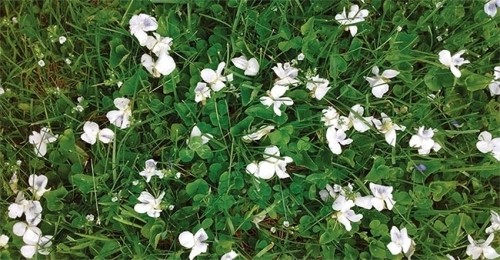Lawns cover 63,000 square miles of the United States, making turf the largest irrigated crop in the country. As much as some ecologists consider lawns to be biological deserts that Americans should be encouraged to eliminate from their properties, it is unlikely lawn cover will decline anytime soon.
So urban ecologist Susannah Lerman at the U.S. Forest Service’s Northern Research Station in Amherst, Massachusetts, decided to figure out how to make lawns “less bad” by examining how lawns might be maintained in a way that would provide habitat for declining populations of bees.
“While not everybody uses herbicides on their lawn, the thing almost everybody does is mow,” Lerman said. “We wondered if there were ways we can tweak this behavior to make it less bad for bees. You see a lot of dandelions and clovers growing spontaneously. Do these plants have ecological value as bee habitat?”
In an assessment of 16 suburban lawns in Springfield, Massachusetts, she found that lawns that were not treated with herbicides or pesticides yielded an unexpectedly rich abundance of bee species and an equally impressive variety of what Lerman called “spontaneous flowers” – those that are not intentionally planted but which provide nectar and pollen to bees and other pollinators.
After visiting each yard 12 times over a span of two years, she was surprised to discover 64 flowering plant species spontaneously growing in the lawns, including violets, creeping Charlie, hairy rockcress, purple smartweed, and dwarf cinquefoil. “You go into these yards, and at first glance it looks like there’s nothing there,” she said. “But then you start looking, and there’s a lot more in there than you think.”
Even more surprising, Lerman and colleague Joan Milan identified 111 different species of bees on the properties. “It was astonishing!” she said. “We recorded a quarter of all the bee species ever found in Massachusetts on these 16 suburban lawns. One yard had 53 species of bees.” Strangely enough, the most abundant species was a type of sweat bee not recorded in the state since the 1920s.
Lerman’s study also found that bees were most abundant on lawns mowed every two weeks, compared to those mowed weekly or every three weeks.
“Clearly there is value in these landscapes for habitat conservation,” Lerman said. “Private yards shouldn’t be ignored when thinking about conservation.”
To improve habitat for bees and other pollinators, she said that homeowners should consider reducing or eliminating the use of pesticides and herbicides on their lawns, plant a nearby meadow or pollinator garden if possible, and encourage the growth of spontaneous plants in their lawns.
The latter suggestion may be difficult for some people to follow, Lerman said. “Most people look at dandelions and clovers and see them as weeds. We need to change their perceptions and show that those plants are really providing wildlife habitat.”
And mowing less frequently will not only result in a lawn with more flowers and more bees, it’ll require less work. “It’s a way to do less but feel like you’re making a difference even though you didn’t spend any extra time or money.”


